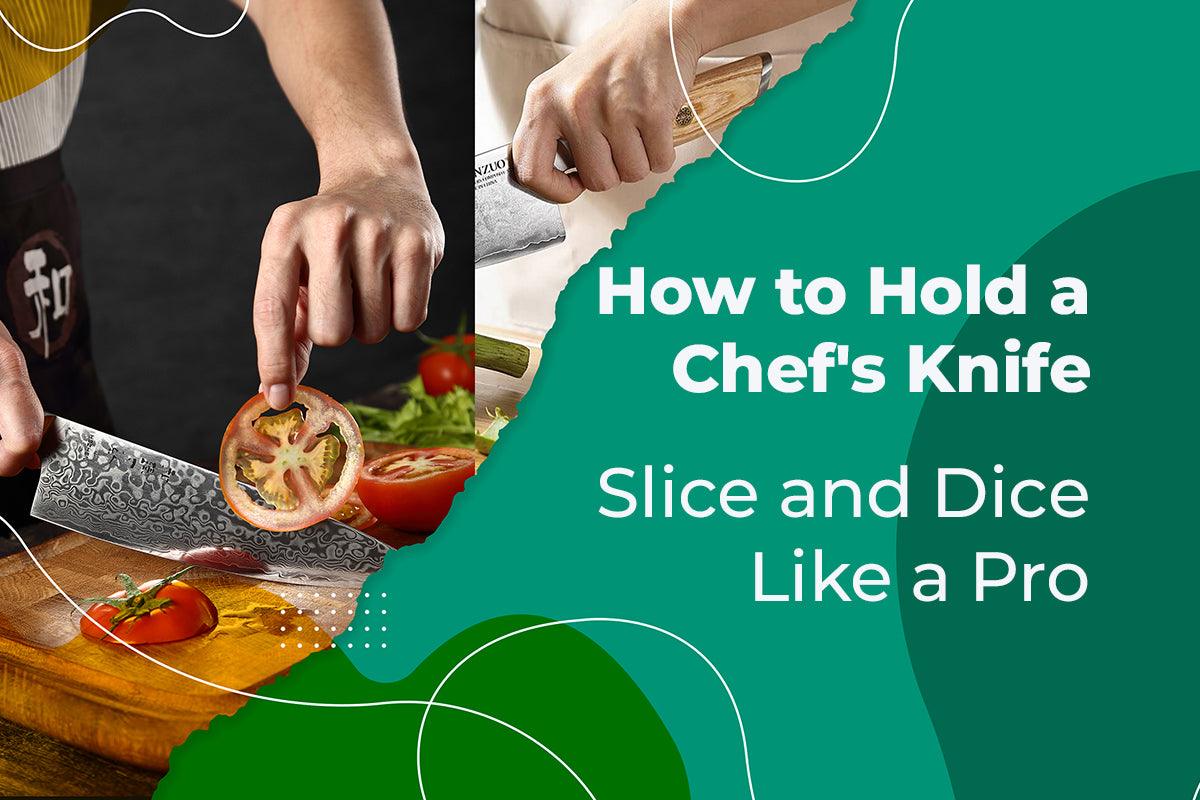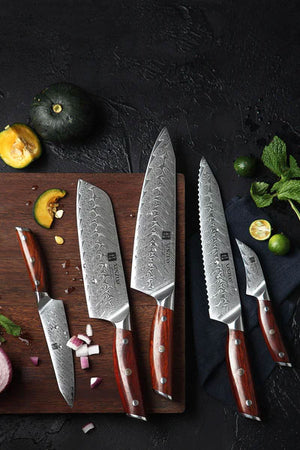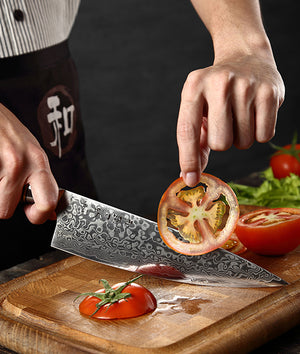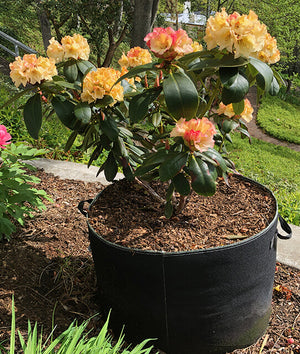
How to Hold a Chef's Knife and Slice and Dice Like a Pro
Most of the techniques you use in the kitchen are important because they contribute to your ability to cook effectively and produce tasty food. But another reason it's really important to use the proper techniques is for safety purposes, and this is particularly true for knives.
When it comes to chopping, carving, slicing, and dicing, there are a few aspects of technique that you need to master. First, it's how to hold a knife, which isn't quite as simple as you may think. In fact, there are several common mistakes that amateur chefs make that have the potential to end in injury or damage to their knives, and nobody wants that!
After knife holding comes the specific techniques – that is, how to perform all of the particular methods of using your knife. We're talking about chopping, slicing, and mincing.
But it's not all about what you do with your knife at the moment. One of the most important things that you can do to make your life easier (and safer) when chopping things up in the kitchen is to keep your knives sharp. The sharper your knives, the less likely you are to have your blade slip and accidentally injure yourself!
Something that can make things even easier when you're slicing and dicing is using the appropriate knives for whatever it is that you're doing. And it's not just about knives – you need to use the right cutting boards too. Believe it or not, if you get these two things right, your life will immediately be a whole lot easier.
So, we've put together a guide to teach you about all of these things – how to hold a knife, common mistakes people make when holding knives, tips for specific cutting methods, important chopping skills, the importance of using sharp knives, and the appropriate knives and chopping boards to use for specific things.
I assure you that once you're done with this guide, you'll be ready to cook up a storm in no time! And using the correct techniques and tools no less. Let's get into it!
Tips on How to Hold a Chef's Knife and Slice and Dice Properly
There aren't exactly a hell of a lot of ways to hold a Chef's knife – it's not like there's a long list of different grips you can choose from. So, in reality, it's pretty simple, and we're going to stick to the two main ways in which you can grip your knife.
To begin with, the handle is the part of the knife you hold – well, obviously. You don't grip the blade whatsoever (other than possibly putting pressure on the spine with your non-dominant hand, but we'll get to that later).
Now that we've established the obvious, let's consider the most common type of grip that people tend to start off with.
The Full Handle Grip
The full handle grip is pretty self-explanatory – it involves simply wrapping all fingers around the handle. This grip is generally used by beginners, those who aren't too confident with knives, or anyone who's recently started using a Chef's knife (that may be larger than what they’re used to).
Now, there's nothing particularly wrong with the handle grip, but the only problem is that it just doesn't give you the most precision and control, even though it's arguably the most natural way that people pick up and use a knife. It's also not really the strongest grip.
So, if you're wanting to try something that'll give you more control, precision, and power, have a look at our next option.
Pinch Grip
The pinch grip is actually pretty straightforward, and it's possible that you've used it unknowingly when trying to cut something small or with precision.
All you need to do is place your thumb on one side (the inside, so to speak) and your index finger on the other side (the outside, for the sake of continuity). Naturally, your index finger will be slightly bent, and your middle finger will rest just below it on the handle for added stability and control. Do this at the top end of the knife – fairly close to the start of the blade – and you'll have exceptional control over whatever it is that you're doing. You really are pinching the knife in between your thumb and index finger, hence the name!
You may very well find that this grip isn't the most natural feeling in the world, but try and stick it out a bit. It's the method used by most professional chefs because it really is the most effective – and simple – way to hold a knife!
What to Do with Your Non-Dominant Hand
But it's not all about how to hold a knife. When you're using a knife in the kitchen, you also need to think about your other hand! Because normally, you're going to need to be holding whatever it is you're cutting in place.
You've probably seen how on cooking shows or in movies, chefs do that thing where they tuck their fingers in cut against the flat part of their fingers instead of their fingertips. Well, that's not just a Hollywood thing – that's actually exactly what you're supposed to do with your fingers just in case you slip. Because, believe it or not, it's actually easier than you may think to cut yourself while cooking, especially if your knife is sharp (as it should be).
We like to call this position "the claw". Basically, as we explained, your fingers are curled inwards so that your fingertips are hidden and you're essentially left with a solid surface – that is, the flat part of your fingers. You use this part of your hand to rest the knife on as you cut – but still not too close! It's mostly just to keep things in place.
Your thumb – in case you were wondering – ought to be pulled back and downwards, pressing on the cutting board, to give you extra stability. But just make sure that it's definitely back from your other fingers because you don't want it anywhere near the blade of the knife!
Common Knife Holding Mistakes
Now that you know how to hold a knife and what to do with your other hand, we're going to have a look at some of the most common mistakes amateur chefs make when trying to chop, cut, slice, and dice efficiently.
1. Pushing Down on the Spine of Your Knife
It's not an absolute no-no, but generally speaking, we'd advise that you avoid pushing down on the blade of the knife. There are a few reasons for this.
First, it means you're more likely to slip – either the knife slipping or the entire cutting board – which could potentially result in an injury. Second, if you're too rough or put too much pressure on it, you stand the risk of damaging your knife. Finally, your other hand would be better used holding whatever it is you're slicing or chopping (as we explained above).
2. Positioning Your Index Finger on the Spine
Often, people place their index finger on the spine of the knife because it creates the illusion of providing more precision and control. Now, if you're using a smaller knife, this would probably be true, but not so much with a Chef's knife – it's just too big. Also, putting your index finger on the spine of the blade actually also takes away your strength somewhat.
When it comes to how to hold a knife, you're far better off using the pinch method, in which your index finger is placed on the outside of the knife handle. When you're using a Chef's knife, this is actually how you'll end up with more control and precision.
3. Holding Your Knife Handle Too Far Back
For some reason, many people's natural instinct is to hold the knife at the back of the blade – as in, very close to the butt (check out our article on the different parts of a knife to see exactly what we mean). Perhaps it's out of fear of getting too close to the sharp blade – who knows!
Now, the problem with this is pretty simple – the further away from the blade you hold your knife, the less strength and control you're going to have. It's kind of like holding a pen – if you hold it at the top, you're going to struggle to write properly. But, if you hold it closer to the bottom (also kind of using a pinching grip, funnily enough), you'll have far more control. So, much in the same way, the closer to the blade (on the handle) you hold your knife, the better.
How to Chop, Slice, and Mince Using a Chef's Knife
How to hold a Chef knife might be pretty straightforward, but when it comes to the different techniques you can use with a knife while cooking, it's a little bit more complicated. Mostly because different foods require different methods.
So, we're going to focus on the three main ones – chopping, slicing, and mincing – and we're going to give you detailed instructions on exactly how to do each one effectively (and safely).
How to Chop Using a Chef's Knife
- Hold your knife (using the above-prescribed grip) as close as possible to the heel.
- Place whatever it is that you're chopping parallel to the end of the board and hold it using the claw technique (also, as explained above).
- Chop downwards while pushing the knife slightly forward as you chop and lift the knife again (in a uniform motion) before chopping once again.
- Remember to keep your other hand in the claw position and your fingertips safely tucked away while you use your thumb for stability.
How to Mince Using a Chef's Knife
Mincing, when it comes to herbs (not meat), is the process is finely chopping whatever it is you're using.
Here's how you do it:
- Place whatever it is you’re using (whether it’s garlic, herbs, nuts, ginger, shallots, etc) on your cutting board.
- Place the tip of your knife on the cutting board just ahead of what you're chopping, so that the rest of the blade looms above it.
- Rest your other hand on the spine of the blade near the bolster and move the knife up and down (up two to three inches should be fine) as you mince your chosen ingredient.
- Once you've gone through everything once, use the spine of your knife to push it all back together into a clump and repeat the process a few times until it's finely chopped to your satisfaction. Just make sure you don't use the sharp edge of the blade – this will make it dull and may even damage it!
How to Slice Using a Chef's Knife
Slicing is probably the most common technique used with a knife, but even if you think you know what you're doing, you may not be totally right.
Here's how you should be doing it:
- Place the ingredient you're slicing on your cutting board – most likely a fruit or vegetable.
- If it's an irregular shape or size, cut off one of its ends so that you can place it down securely (flat side down).
- Position the tip of the blade on the cutting board ahead of your ingredient so that the rest of the blade is above it.
- Create the claw shape with your left hand and position it appropriately on your chosen ingredient.
- Slice downwards, and once you've sliced straight through, lift it up again and repeat the motion, moving over slightly to create new slices.
Why It's Important for Your Knives to be Sharp
As we've seen, there are lots of things you need to know about how best to use a Chef's knife – how to hold it, the different techniques, and so on. But one of the most essential things to remember is that your knives need to be sharp, and here's why:
Efficiency and Ease of Use
A sharp knife simply works better than a dull one. You'll be able to do the job properly without any hassle. It'll also prevent you from becoming fatigued as the chef – a blunt knife requires more work (and more elbow grease).
Safety
If your knives are sharp, it'll be easier to slice or chop whatever you're working with, but it'll also make it safer because your knives will work better. This means that they'll cut through food properly – they won't get stuck or slip. The sharper your knives, the safer they'll be to use.
To Make the Food Look Pretty
A sharp knife will make your cutting, chopping, or slicing more effective – and clean! That way, whatever you're cutting, it’s sure to look way better than if you were to use a dull knife that would probably create ugly, jagged slices or uneven chops.
Control
Since a sharp knife is more effective, it's also easier to use, and you'll have way more control than if it's dull. A dull knife is unpredictable, and that's not a great quality for a sharp object to have!
Longevity of Your Knife
Keeping your knives sharpened and honed is the best thing you can do for them in the long run. Not only will they look good and be more effective, but you'll avoid putting undue stress on the blades. Also, it's far easier to sharpen a blade that's already fairly sharp, rather than waiting until it becomes completely dull.

At the end of the day, keeping your knives nice and sharp means that they'll be more effective and efficient, the process will be safer and more controlled, and your final product will be way more aesthetically pleasing – it's a no-brainer!
Best Types of Knives for Slicing and Dicing
If you don't know a lot about kitchen knives, you may be pretty surprised to learn that there are actually many different types. And, they differ based on several components – mainly their shape, purpose, and the material from which they're made. But whether you're looking for a Damascus steel knife or a straightforward steel knife, we've got you covered at Bamboo Guy.

But the question right now isn't about all the different types of knives we offer (but if it were, you'd be able to find them here). We want to tell you about the best type of knife for slicing and dicing. Note, however, that we're not going to include the obvious ones (like bread and cheese knives), because we’re pretty sure you can figure those ones out yourself!
As for the rest, here's what they ought to be used for.
Chef's Knife
The Chef's knife (our favorite) is one of the most versatile of the bunch. It can be used for fruit, vegetables, meat, or fish. This has a lot to do with the fact that it's pretty large.

Paring Knife
Since a paring knife is significantly smaller than a Chef's knife, it's a good thing to use for things that the Chef's knife is too big for. For instance, peeling an apple or a potato, coring a pepper, or even mincing a very small amount of herbs. Pretty much anything that requires a bit more precision.

Utility
If you're looking for the ultimate versatile knife, it would have to be the utility knife. It's bigger than a paring knife (with a longer blade) but narrower than a Chef's knife. You can do pretty much anything with it, from chopping vegetables to cutting a sandwich in half or slicing meat.
Boning
Long and thin, a boning knife (as it may suggest) is used for cutting meat directly off the bones – but not cutting actual bone!
Decorating
Decorating knives are pretty much only for aesthetic purposes, as they have a pattern on the face of the blade that can be used to create an imprint on whatever food you're preparing.
Other types of knives that we didn't really think were necessary to explain include bread knives, tomato knives, cheese knives, a cleaver, mincing knives, and carving knives.
At the end of the day, when it comes to the best knives for slicing and dicing – that is, the most versatile knives – we'd have to opt for the good old Chef's knife and the ever-hand utility knife. With these two tools in your kitchen, you can’t go wrong!
Best Cutting Boards for Chopping
The other thing that has a big influence on your chopping experience is your cutting board. That is, how you use it and what kind of board you use. Because the type of cutting board you use can influence the safety of the process, how effective it is, as well as the condition of your knives. So, let's have a quick look at the best cutting boards you can use.

Glass Cutting Boards
These days, glass cutting boards are mostly a thing of the past, but not completely! Some people still use them, but you really shouldn't. Why?
Glass is incredibly hard and abrasive on your knife blades. Repeated use of a glass cutting board will lead to your blades' edges becoming dull very quickly. But, it's not just about sharpness – you also run the risk of damaging the blades because the glass is so hard.
Another concern with glass cutting boards is that they can be slippery, so you run the risk of slipping and cutting yourself. Not ideal! Overall, we'd suggest staying away from glass.
Plastic Cutting Boards
There are different types of plastic cutting boards, and we'll give you a quick synopsis of each type.
The first type – the ones made from ordinary plastic – are a pretty cost-effective option. But unfortunately, they come with a few cons:
- They're more likely to harbor bacteria in the grooves made by cutting.
- Their shape distorts in warm water.
- They can be slippery.
- They don't last long.
- They tend to contribute to the dulling of knife blades – they're not particularly gentle.
However, you do get some plastic boards that are made of a special kind of plastic – high-density polyethylene (HDPE) – which is far softer than ordinary plastic. That means it's less likely to have lots of grooves from ordinary, day-to-day cutting, they're not as abrasive on knife blades, and they last way longer.
Rubber Cutting Boards
Rubber cutting boards are actually incredibly popular – and for good reason. Unlike ordinary plastic, you won't find deep grooves, so they're more sanitary and last far longer.
Unfortunately, they do have a few disadvantages:
- They can be expensive.
- Not particularly aesthetically pleasing.
However, having said, you do actually get two different varieties, so you can pick the one that suits you best based on your needs and preferences.
The thinner carving knife are cheaper, and they're dishwasher safe. The thicker ones (about half an inch thick) have the potential to be resurfaced, so they may be more expensive, but in the long run, this may be a better investment.
Wooden Cutting Boards
Most people would probably agree that wooden cutting boards are the most attractive of the lot. Here are some other advantages of wooden cutting boards:
- They're soft and gentle on knife blades.
- Cut marks/grooves aren't always permanent – sometimes, the wood can repair itself.
- They're heavier so they're less likely to slip.
When it comes to disadvantages, the main issue is that they require a specific type of maintenance and cleaning. But, having said that, it's not really too much work, so it's worth it!
Here are the main features of the different types of wooden cutting boards based on grain type:
Face Grain Wood Cutting Boards
- Horizontal grains
- Attractive pattern
- They tend to show knife marks quite easily.
Edge Grain Wood Cutting Boards
- Horizontal grains
- More durable than face grain because the grain of the wood isn't as exposed.
- Thicker and heavier, so they're more stable.
End Grain Wood Cutting Boards
- Vertical grains
- Hardly shows knife marks
- The most gentle on knife blades
- Very durable
- Wood is self-healing
- More expensive
- Original butcher block cutting boards
At the end of the day, the best quality wooden cutting board you can get is an end grain wood cutting board. So, if you want the best of the best that'll last the longest (and you aren't afraid to pay for it), this is your best bet.
Final Thoughts on How to Hold a Chef's Knife and Slice and Dice Like a Pro
There you have it – everything you need to know about how to hold a knife, common mistakes people make when holding knives, tips for specific cutting methods, important chopping skills, the importance of using sharp knives, and the appropriate knives and chopping boards to use for specific things.
With this knowledge in hand, there's nothing stopping you from becoming a whizz in the kitchen and always keeping safe!



